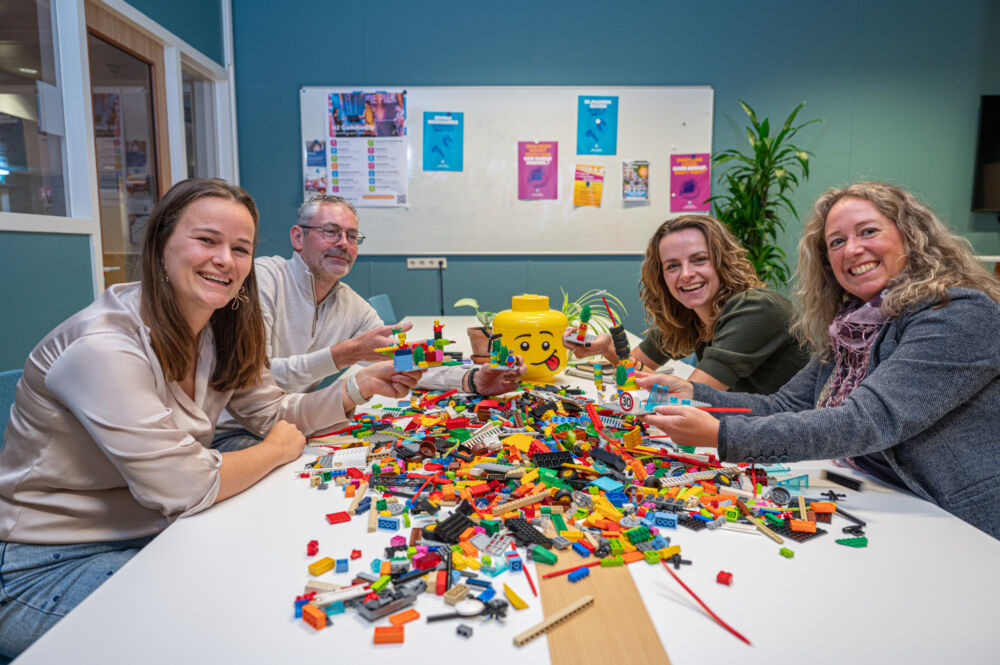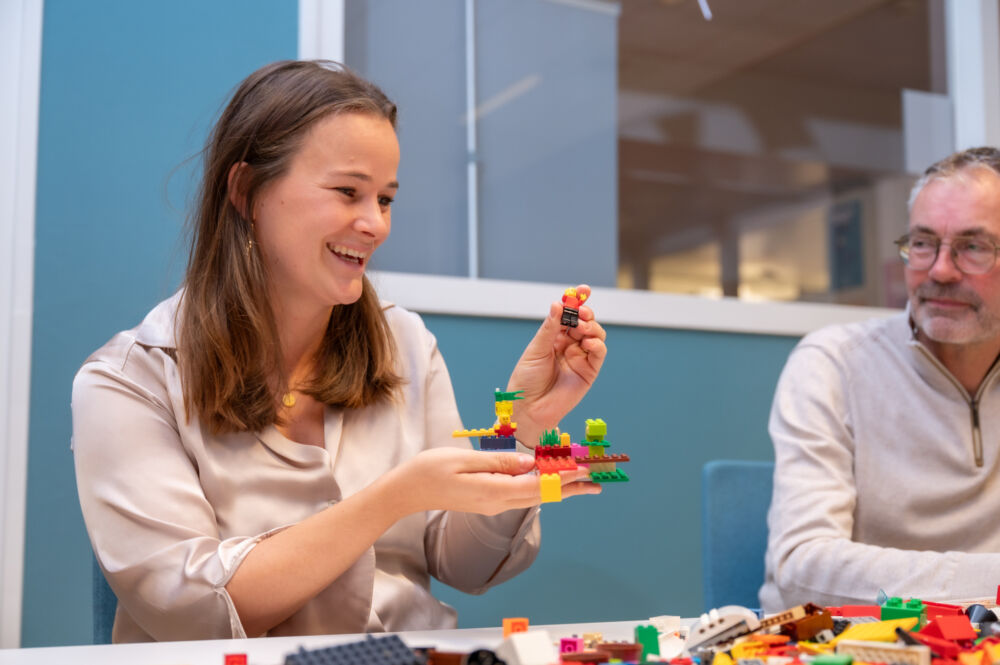Sophie Adriaanse, Judith van Poppel, Marjoleijn Felius and Leo Blok are certified facilitators of the LEGO Serious Play methodology. Equipped with a box of LEGO, they help teams and students explore and solve innovative issues and complex challenges.
With the LEGO Serious Play method, teams explore complex issues using Lego. By building Lego models individually and collectively – and reflecting on them – ideas, solutions and feelings become literally visible. Working with their hands stimulates the brain to make new connections – and thus to think creatively and innovatively. While talking and building, the group works towards a single joint model that expresses their shared vision or solution.
Anyone who spent hours playing with LEGO bricks in the past may not immediately associate the name LEGO Serious Play with a structured method for unravelling and solving complex challenges. Yet that is exactly what the four facilitators see happening during their team sessions with students or colleagues.
Marjoleijn: "We sometimes say that teams can come up with more creative insights and connections in an hour and a half of LEGO play than they can in a meeting with 10 people in the same amount of time. LEGO Serious Play is playful, informal, often enjoyable, but it is also a very useful investment of time for teams."
Sophie: "Even though you might not immediately associate it that way, LEGO Serious Play is a very serious and goal-oriented approach, but packaged in a way that allows you to enjoy building together. That combination is what makes it work so well."
Marjoleijn: "The method really lends itself to more complex issues or team challenges. For example, when developing a vision, determining policy, but also team challenges and change processes. These are themes that take time to properly investigate. You really have to take the time for this, so it's not a substitute for every meeting."
The time limit ensures that you do not get stuck in thinking mode, but that your hands are the ones taking action.
Thinking with your hands
A session with LEGO Serious Play stimulates our creative thinking. But how does it actually work? What makes participants suddenly become so creative and solution-oriented as soon as they start working with the bricks?
Leo: "This method appeals to thinking through our hands. Because you are building with your hands, your brain makes different connections and you think more creatively than when you are only thinking or talking."
Judith: "Building with your hands quickly puts you in a flow. Surprising and innovative insights quickly emerge within the group. Even among people who claim beforehand that they are 'not creative at all'."
Sophie: "During the construction assignments, the facilitator deliberately sets a strict time limit. For example, you are given 90 seconds to depict how you experience the collaboration within your team. This time limit ensures that you don't get stuck in thinking mode, but that your hands are the ones taking action. You simply don't have time to think or hesitate for long. If we, as facilitators, give too much time, your head would take over again."

Building a shared narrative
LEGO Serious Play sessions begin with participants building individual models to illustrate a problem that needs to be solved. By sharing and discussing these constructions with each other, the separate models gradually transform into a single joint model. The process leading up to this – guided step by step by the facilitator – is the reason why LEGO Serious Play is more than just building.
Leo: "The beauty of LEGO Serious Play, in my opinion, is that as a group you give meaning to what you build together. As you talk, you create a context around it. Without shared meaning, you are all looking at nothing more than a collection of bricks. It forces you to articulate what you really mean by that shared vision or team agreement – and to reach consensus on it together.”
Sophie: "The power of LEGO Serious Play also lies in the level of engagement. In traditional meetings, some people do most of the talking, while others contribute less. I see the same thing with my students. Dominant opinions can easily steer the collective outcome. With this method, you tap into the potential of the entire group. Every individual feels part of the end result, which ensures commitment."
In meetings, some people speak a lot, others less. With this method, you can harness the potential of the entire team.
LEGO, isn't that a bit childish?
A table full of LEGO while you are trying to get to the bottom of a serious problem together: does that sometimes cause resistance? How does such a playful approach affect the atmosphere? And what effect does it have on difficult conversations?
Marjoleijn: "I mainly facilitate sessions for teams within HZ. In my experience, colleagues are very open to it. In addition to the creative aspect, the playful and informal element has another important function: it can lighten the mood when dealing with sensitive topics. For example, when you find it difficult to directly address someone about certain behaviour within your collaboration. By illustrating it with LEGO figures, you create a little distance, for yourself and for the other person. You can then talk about it in a more light-hearted way, while the image comes across very clearly."
Sophie: "Of course, some of my students are boys and girls who think beforehand: what am I supposed to do with this? But in my experience, everyone starts building in no time and all their 'hesitation' or 'doubt' disappears. Then you see everyone getting into that creative flow and the most beautiful conversations and ideas emerge."
Judith: "LEGO creates a fun and positive atmosphere. There is generally a lot of laughter during a session. No matter how serious the theme or challenge may be, there is also an element of team building. In that respect, this method fits in very well with the major challenges and transitions that HZ is facing. And with the personal and positive way in which we work together here."

What is the role of the facilitator?
All facilitators have completed a multi-day training course to fully master the method. Because behind the apparent simplicity of the LEGO bricks lies a well-thought-out method. But how do you ensure that such a session really works? And that participants feel safe enough to share their ideas?
Sophie: "It's not something you can just do without guidance from someone trained in the method. LEGO Serious Play only works if the process is carefully constructed and monitored. A facilitator asks the right questions at the right time and tailors assignments to the dynamics at the table. This helps participants get into a flow, where they feel comfortable to build freely and express themselves."
Judith: "A LEGO Serious Play session must also comply with the guidelines of the method, which is why it is preceded by a multi-day training course for facilitators. One of the most important basic rules is that everyone "has an obligation to build" and "has the right to express their own story behind the model". Without being interrupted by the judgement of others. This way, everyone feels part of the process and you create a high level of commitment to the set goals."
LEGO Serious Play fits in very well with the challenges and transitions that HZ is facing and with the personal and positive way in which we work together here.
How do Leo, Sophie, Marjoleijn and Judith use LEGO Serious Play themselves?
Marjoleijn: “I mainly give the sessions to teams within our organisation. They cover topics ranging from change issues to educational development and improving cooperation within a group. How do we view a problem as a team? What is our share? What steps can we take? These sessions are not only useful, but often also very enjoyable.”
Leo: "I took the training at the time because it could be useful in my role as a manager. But sometimes I also coach other teams or training programmes. I really enjoy doing that. Soon, I hope to give a session for the Maritime Officer study programme."
Sophie: “Judith and I mainly use it in our courses. In Tourism Management, the method is used once every academic year, so that students are introduced to different working methods, such as a scrum game or LEGO Serious Play. Sometimes I also help other courses by giving a session. Colleagues are always welcome to send us a message to see if we can organise something.”
Judith: “Sophie is my successor at Tourism Management, where I also gave the sessions. It is also a great method for Food, Business & Innovation. We are certainly enthusiastic about using it more widely, time permitting. Fortunately, we still have a number of facilitators within HZ. We work together in a Teams environment to exchange experiences, but also to make better use of each other's knowledge."
